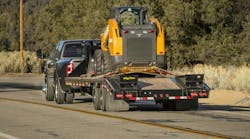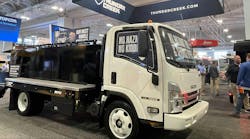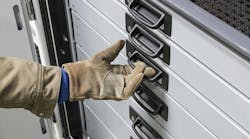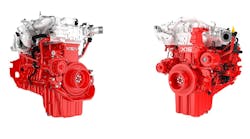After a long layoff, International Truck & Engine is returning to the low-cabover-engine market with a new Class 4 and 5 CF Series due out early next year. The CF, for cab-forward, will also be the first use of a new V-6 diesel, and the first time International will offer a truck at the lighter end of the midrange spectrum.
Although most North American customers prefer conventional-cab trucks—a major reason International dropped its Cargostar low-cabover in the early 1980s and its 9800 high cabover in the mid '90s—low-cab-forwards, as International calls them, now constitute a "growth market," said International's medium-duty marketing manager, Rob Swim. Increasing traffic congestion on highways will make such vehicles' compactness and high maneuverability as useful as they are on urban streets and alleys, and on crowded jobsites.
The CF will attempt to grab some of the low-cab-forward (LCF) business being abandoned by Hino Trucks, which announced a domestically built conventional to replace its current models, as well as business now held by other Japanese LCF builders, he said.
The CF was designed for and will be built in North America, Swim said. Most of its components will be sourced here, and it will be supported by more than 1,000 International dealers. Current customers have said they can use an LCF, and would prefer that it be a domestic product, he added.
The new series includes two models: a CF500, rated at 16,000 pounds gross vehicle weight, and a CF600, rated at 19,500 pounds GVW. They will come only with a 200-hp V-6 diesel and a five-speed automatic transmission; no manual transmissions will be offered.
The CF will be easy to drive, with good visibility to the front and sides and a tight turning circle. It will be easy to work on, with readily accessible daily service points and a full tilting cab for walk-up access to the power train.
Frame rails will be positioned 34 inches apart, the North American standard, which will make it easy to mount bodies. The chassis is suitable for a number of construction-oriented bodies, including flats and stakebeds to haul building supplies, machinery service units and landscaper-type dumps, Swim said.
The CF is part of the Blue Diamond joint venture between International and Ford, and there will be a Ford version of the truck. Production will be at the International/Blue Diamond plant in Escobedo, Mexico. Ford will supply its TorqShift 5-speed automatic transmission, now used in diesel-powered SuperDuty pickups and heavier E-series cargo vans. The transmission has PTO capability.
International's new 4.5-liter V-6 diesel, called the VT-275, will be rated at 200 horsepower and 440 pounds-feet of torque. The new diesel is essentially three-quarters of the 6-liter VT365 V-8, which Ford sells as the Power Stroke. Ford was expected to use the V-6 variant in its light-duty trucks and SUVs, but backed away because it couldn't identify sufficient customer demand. International is planning other uses for the V-6 in its own truck products and is talking to other truck builders, Swim said. It previously announced it is also seeking military business for the engine.
The CF's cab is now used by Ford's Japanese partner, Mazda, on the Titan LCF it sells in Asia. The cab's third-party Japanese builder will supply steel stampings to the Escobedo plant for assembly and trimming there. Virtually all of the vehicle's other components will be sourced in North America.
International announced the CF in late January, one year before it will enter production, to alert customers and body builders of its upcoming availability, Swim explained. A Ford spokesperson said it will unveil its version later in the year. Ford has not had an LCF since it sold its Cargo model and HN80 heavy conventionals to Freightliner six years ago to get out of the Class 8 business. The new LCF will complement Ford's existing line of conventional and van-type trucks.






